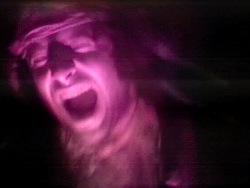Charlemagne Palestine
Biography
Charlemagne Palestine is an influential composer, performer and visual artist. Throughout the 1970s, Palestine produced a seminal body of performance-driven, psychodramatic video works in which he activates a ritualistic use of physicality, motion and sound to achieve an outward articulation of internal states. Intensely personal and often violently charged, these phenomenological exercises are characterized by a visceral enactment of physical and psychological catharses. Performing in isolation with a hand-held, moving camera, Palestine taps the body as a conduit for the self. The very titles of his pieces — Internal Tantrum (1975), Running Outburst (1975) — suggest literal and metaphorical catalysts for release or escape from confinement.
Movement and sound, as they relate to the body and the voice, are the vehicles through which Palestine expels internal energy. Ritualistic vocal expressions — hypnotic chants, trance-inducing tones — become physical translations of anguish and pain, as does the use of the video as an extension of the body. Running frenetically with the camera or strapping it to a moving motorcycle, Palestine uses motion as metaphor. Challenging identity and perception, he positions the viewer behind the camera, in a subjective point of view. Seeing through his eyes, moving with his body, the viewer is both participant and voyeur.
A contemporary of artists such as Steve Reich, Philip Glass and Terry Riley, Palestine’s music and sound compositions have garnered a devoted following since the 1960s. In recent years, he has collaborated with a diverse group of experimental musicians including Pan Sonic, David Coulter, Tony Conrad and Michael Gira. He has released more than twenty solo albums and has performed in festivals around the world such as The Meltdown Festival, London in 1999; Transmediale, Berlin in 2010; All Tomorrow’s Parties, UK in 2010 and Numina Lente, NY in 2011.
In his work in performance, music, video and related media since the late 1960s, Palestine uses certain emblematic objects, including teddy bears, cognac and scarves, as signatures — what he terms "symbols of identification."
Charlemagne Palestine was born in Brooklyn, New York in 1945. He studied at New York University, Columbia University, Mannes College of Music and California Institute of the Arts. He has received grants from the New York State Council on the Arts and the National Endowment for the Arts, among other organizations. His work has been exhibited internationally, at festivals and institutions including the Venice Biennale, Italy; Whitney Museum of American Art, New York; The Museum of Modern Art, New York; Moderna Museet, Stockholm; Kunsthalle, Basel, Switzerland; Long Beach Museum of Art; Museum of Contemporary Art, Houston; Palais des Beaux-Arts, Bruxelles; Stedelijk Museum, Amsterdam; Documenta 8, Kassel; Walker Art center, Minneapolis; Art Institute of Chicago; Centre d’Art Contemporain, Geneva; and Musée d’Art Contemporain, Montreal. In 2010 Palestine’s video works were featured in the solo exhibition "VooDoo" at Wiels in Brussels. Palestine has been selected to participate in the 2014 Whitney Biennial.
Palestine lives and works in Brussels.
